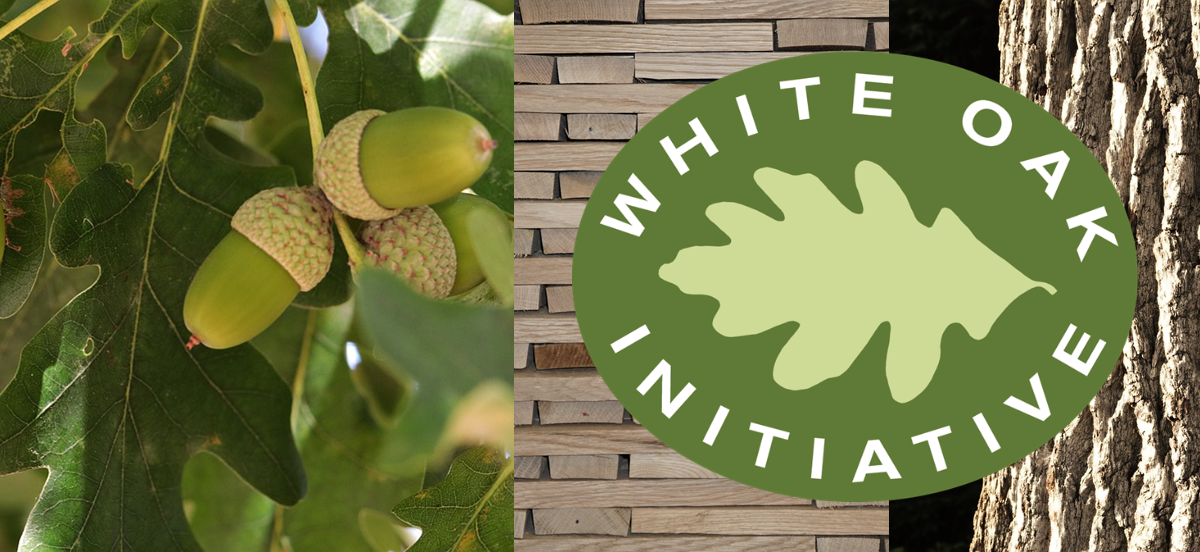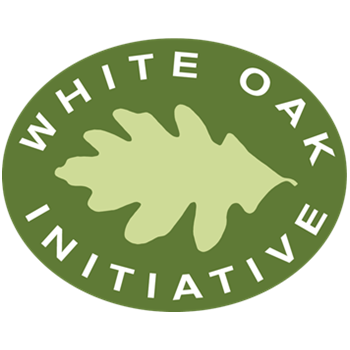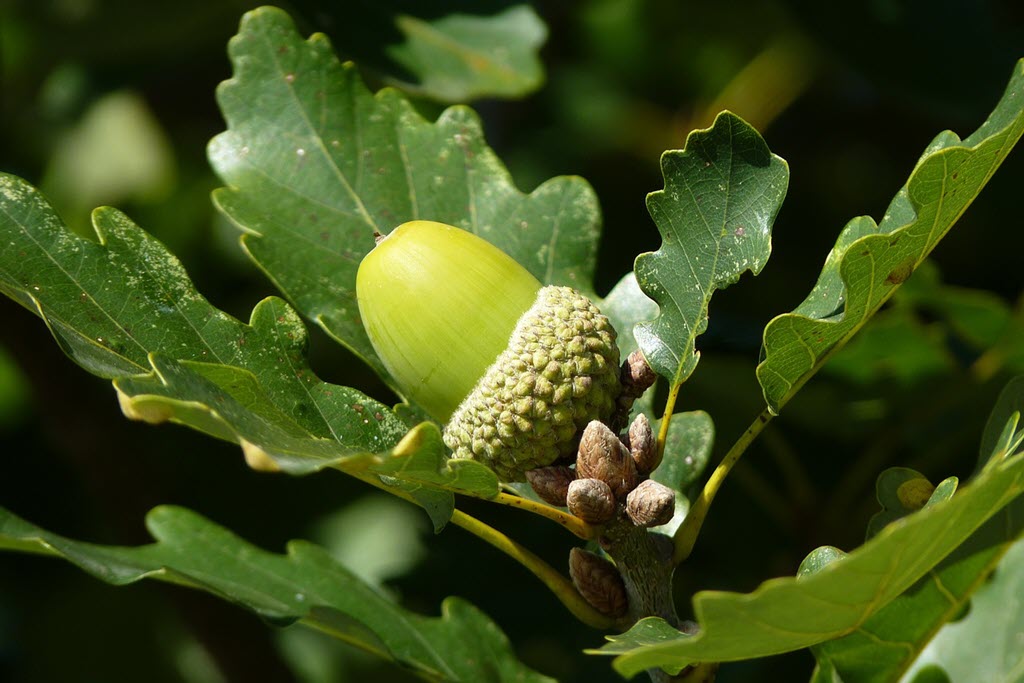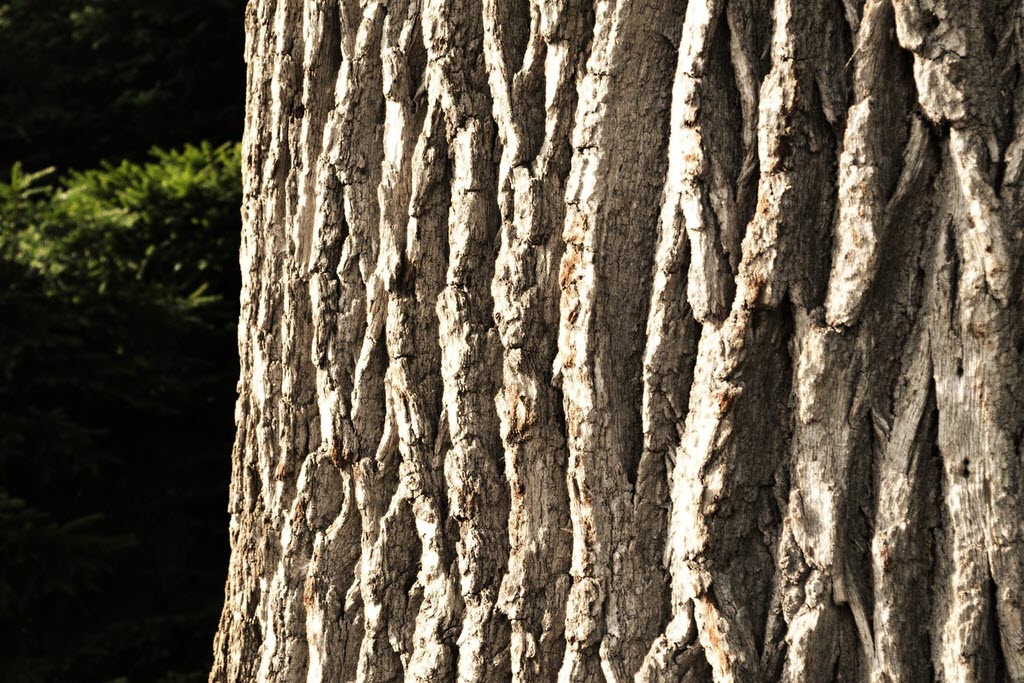
Federal law says bourbon whiskey, America’s Native Spirit, must be made in new charred oak barrels. Just like the corn, rye, wheat, and barley that makes up many bourbon mash bills oak trees are an agricultural product that takes time to plant, manage, grow, and harvest. Without these grains, fresh water, and oak, what we call bourbon today will go the way of the dinosaur.
The White Oak Initiative was created in 2017 by the University of Kentucky, the Dendrifund and the American Forest Foundation. The White Oak Initiative brings together industries, universities, state and federal agencies, nonprofits, private landowners, conservation organizations and trade associations that are committed to ensuring the long-term sustainability of America’s white oak forests as well as the economic, social and environmental benefits they provide.
Sustainability of White Oak Forests
Without action, American white oak forests will disappear in a generation with significant impacts on wildlife, forest ecosystems and timber supplies. White oak is threatened by changing markets, pests and invasives, and inadequate management. Research shows that while the existing white oak stocks are sufficient for estimated near future demand (10-20 years), there are clear indications of long-term sustainability problems.
White oak is not only a cornerstone to the ecosystem, but it also directly impacts the bourbon industry.

Bourbon Caucus Legislation Aims to Safeguard Vital White Oak Resources
The White Oak Initiative has announced its support of the bipartisan White Oak Resilience Act (WORA), introduced in the U.S. House of Representatives (H.R. 5582 full text below).

“While there are plenty of white oak trees out there right now, the data clearly shows that regeneration isn’t happening at the levels we’ve historically seen, and soon this will be a serious problem for everything from the American bourbon industry to native plants and wildlife if we don’t act today,” said Jason Meyer, executive director of the White Oak Initiative. “Fortunately, this bill proposes much-needed measures to rejuvenate our white oak forests, supporting the hard-working folks who rely on them and promoting biodiversity.”
American white oak is a foundational tree species, currently occupying more than 104 million acres of public and private forestland across much of the eastern and central United States. However, due to shifts in land management and ecological changes, older white oak trees are not being replaced by younger white oak trees at a pace that will support long-term sustainability. This is an issue because white oak resources currently support extensive plant and animal biodiversity, and generate billions of dollars annually through industries such as furniture, flooring, cabinetry, and wine and spirits.


To address this challenge, WORA will protect and help revive the white oak population across the full range. A primary provision of the bill will mobilize a White Oak Restoration Initiative Coalition of public, private and other non-governmental bodies to coordinate and encourage more effective forest management practices.
The bill would create:
- A formal USDA White Oak Restoration Initiative Coalition that would prioritize and coordinate white oak projects
- New white oak restoration and regeneration pilot projects coordinated through the U.S. Forest Service and Department of the Interior
- A private-sector white oak restoration fund
- A nationwide strategy and implementation plan expanding the capacity of tree nurseries
- Expanded research of white oak by land-grant universities and the U.S. Forest Service
Cosponsored by Congressional White Oak Caucus and Congressional Bourbon Caucus leaders Andy Barr (R-KY), Ami Bera (D-CA), Steve Cohen (D-TN), Scott DesJarlais (R-TN) and Morgan McGarvey (D-KY), WORA showcases the power of public-private partnership, and the integral relationship between the resilience of our natural resources and economic growth.
A Toast to the White Oak
Stay Informed: Sign up here for the Distillery Trail free email newsletter and be the first to get all the latest news, trends, job listings and events in your inbox.
Barr Introduces Legislation to Ensure Longevity of Kentucky Bourbon Industry
Congressman Andy Barr (KY-06) introduced the White Oak Resilience Act, a crucial piece of legislation which would ensure a sustainable future of the American white oak. This legislation addresses the critical shortages faced by the white oak population, underlining its vital importance to the environment, the economy, and the bourbon industry. The act’s key provisions range from authorizing the Department of the Interior (DOI) and the Forest Service to actively participate in white oak restoration projects to harnessing private investment and establishing a white oak restoration fund to support white oak regeneration on national forests.
“The White Oak Resilience Act is not just about saving trees; it’s about preserving our heritage, safeguarding biodiversity, and fortifying an industry that is critical to Kentucky’s economy,” said Congressman Barr. “The future of the bourbon industry, which relies on the unique characteristics of white oak barrels, and the future of countless ecosystems are intertwined with the sustainability of the white oak.”
“I am proud to join Rep. Barr and our colleagues in introducing the White Oak Resilience Act to provide long-term sustainability for our white oak forests. White Oak forests cover millions of acres across the country and support numerous wildlife and plant ecosystems while also providing a critical resource for several American industries from furniture to wine and spirits. This bill is a comprehensive investment in the conservation and restoration activities across several federal land management agencies for white oak trees. I look forward to getting this bill passed into law so we can conserve this critical resource for generations to come.” -Congressman Ami Bera (CA-06)
“White Oak trees are an essential part of the whiskey making process for our many Tennessee distilleries. I support the White Oak Resilience Act so that these businesses can continue to thrive and our famous Tennessee whiskey enjoyed around the world.”- Congressman Scott DesJarlais (TN-04)
“Maintaining healthy white oak forests is important for the environment and for a wide range of industries in Tennessee, including furniture, flooring and in the manufacture of oak casks for Jack Daniels whiskey production. Since it takes 60 to 100 years for white oaks to reach maturity, the time to act is now to ensure white oak is available for future generations.”- Congressman Steve Cohen (TN-09)
“I’m proud to join Rep. Barr to protect the white oak tree population for decades to come,” said Rep. McGarvey (KY-03). “It’s crucial we take action to grow more white oak trees now — it’s good for our planet, our economy, and let’s face it, you can’t make bourbon without it. The White Oak Resilience Act will help maintain our white oak population, ensuring economic success, environmental stewardship, and good bourbon well into the future.”
“While there are plenty of white oak trees out there right now, the data clearly shows that regeneration isn’t happening at the levels we’ve historically seen, and soon this will be a serious problem for everything from the American bourbon industry to native plants and wildlife if we don’t act today,” said Jason Meyer, Executive Director of the White Oak Initiative. “Fortunately, this bill proposes much-needed measures to rejuvenate our white oak forests, promoting biodiversity and supporting the hard-working folks who rely on them.” To protect and enhance American white oak, all parties need to work together — thinking, planning and acting — to prevent a crisis. Collectively, we must help landowners and forest managers actively manage our oak forests to restore their health by removing competing tree species, prevent diseases and invasives, and create openings for this sun-loving tree to flourish for without the might oak, there is no bourbon.
‘White Oak Resilience Act’ — H.R. 5582
118th CONGRESS
1st Session
H. R. 5582
To provide for white oak restoration, and for other purposes.
_______________________________________________________________________
IN THE HOUSE OF REPRESENTATIVES
September 20, 2023
Mr. Barr (for himself, Mr. Bera, Mr. DesJarlais, Mr. Cohen, and Mr.
McGarvey) introduced the following bill; which was referred to the
Committee on Agriculture, and in addition to the Committees on Natural
Resources, and Education and the Workforce, for a period to be
subsequently determined by the Speaker, in each case for consideration
of such provisions as fall within the jurisdiction of the committee
concerned
_______________________________________________________________________
A BILL
To provide for white oak restoration, and for other purposes.
Be it enacted by the Senate and House of Representatives of the
United States of America in Congress assembled,
SECTION 1. SHORT TITLE.
This Act may be cited as the ``White Oak Resilience Act''.
SEC. 2. WHITE OAK RESTORATION INITIATIVE COALITION.
(a) In General.--The White Oak Restoration Initiative Coalition
shall be established--
(1) as a voluntary collaborative group of public, State,
private and non-governmental organizations to carry out the
purposes described in subsection (b); and
(2) in accordance with the charter titled ``White Oak
Initiative Coalition Charter'' adopted by the White Oak
Initiative Board of Directors on March 21, 2023 (or a successor
charter).
(b) Duties.--In addition to the duties specified in the charter
described in subsection (a)(2), the duties of the White Oak Restoration
Initiative Coalition are--
(1) to coordinate public, State, local, private and non-
governmental restoration of white oak in the United States; and
(2) to make program and policy recommendations with respect
to--
(A) changes necessary to address Federal and State
policies that impede activities to improve the health,
resiliency, and natural regeneration of white oak;
(B) adopting or modifying Federal and State
policies to increase the pace and scale of white oak
regeneration and resiliency of white oak;
(C) options to enhance communication, coordination,
and collaboration between forest land owners,
particularly for cross-boundary projects, to improve
the health, resiliency, and natural regeneration of
white oak;
(D) research gaps that should be addressed to
improve the best available science on white oak;
(E) outreach to forest landowners with white oak or
white oak regeneration potential; and
(F) options and policies necessary to improve the
quality and quantity of white oak in tree nurseries.
(c) Administrative Support, Technical Services, and Staff
Support.--The Secretary of the Interior and the Secretary of
Agriculture shall make such personnel available to the White Oak
Restoration Initiative Coalition for administrative support, technical
services, and development and dissemination of educational materials as
the Secretaries determine necessary to carry out this section.
(d) Nonapplicability of Federal Advisory Committee Act.--Chapter 10
of part I of title 5, United States Code, shall not apply to the White
Oak Restoration Initiative Coalition.
(e) Private Funding of White Oak Restoration Projects.--The
Secretary of Agriculture may make funds available to the White Oak
Restoration Initiative Coalition to carry out this section from the
account established pursuant to section 1241(f) of the Food Security
Act of 1985 (16 U.S.C. 3841(f)).
SEC. 3. FOREST SERVICE PILOT PROGRAM.
(a) In General.--The Secretary of Agriculture, acting through the
Chief of the Forest Service, shall establish and carry out 5 pilot
projects in national forests to restore white oak in such forests
through white oak restoration and natural regeneration practices.
(b) National Forests Reserved or Withdrawn From the Public
Domain.--At least 3 pilot projects required under subsection (a) shall
be carried out on national forests reserved or withdrawn from the
public domain.
(c) Authority To Enter Into Cooperative Agreements.--The Secretary
of Agriculture may enter into cooperative agreements to carry out the
pilot projects required under subsection (a).
SEC. 4. DEPARTMENT OF THE INTERIOR WHITE OAK REVIEW AND RESTORATION.
(a) Assessment.--
(1) In general.--The Secretary of the Interior shall carry
out an assessment of land under the administrative jurisdiction
of the Department of the Interior, including fish and wildlife
refuges and abandoned mine land, to evaluate--
(A) whether white oak is present on such land; and
(B) the potential to restore white oak forests on
such land.
(2) Use of information.--In carrying out the assessment
under paragraph (1), the Secretary may use information from
sources other than the Department of the Interior, including
from the White Oak Initiative and the Forest Service.
(3) Report.--Not later than 90 days after the date of the
enactment of this section, the Secretary shall submit to
Congress, and make publicly available on the website of the
Department of the Interior, a report regarding the results of
the assessment carried out under this subsection.
(b) Pilot Projects.--After the date on which the report required
under subsection (a)(3) is submitted, the Secretary shall establish and
carry out 5 pilot projects in different areas of land described in
subsection (a)(1) to restore and naturally regenerate white oak.
(c) Authority To Enter Into Cooperative Agreements.--The Secretary
of the Interior may enter into cooperative agreements to carry out the
pilot projects required under subsection (b).
SEC. 5. WHITE OAK RESTORATION FUND.
Section 409 of the National Forest Foundation Act (16 U.S.C. 583j-
7) is amended--
(1) by striking ``The activities'' and inserting the
following:
``(a) In General.--The activities''; and
(2) by adding at the end the following:
``(b) White Oak Restoration Fund.--
``(1) In general.--Funds described in paragraph (2) shall
be made available for activities--
``(A) on national forests that are approved by the
Secretary, acting through the Chief of the Forest
Service; and
``(B) to--
``(i) re-establish white oak forests where
appropriate;
``(ii) improve management of existing white
oak forests to foster natural regeneration of
white oak;
``(iii) improve and expand white oak
nursery stock; and
``(iv) adapt and improve white oak
seedlings.
``(2) Fund.--The National Forest Foundation may accept
gifts, devises, or bequests for the purposes of carrying out
the activities specified in paragraph (1).
``(3) Summary.--Beginning 1 year after the date of the
enactment of this section, the National Forest Foundation shall
include in the budget justification materials submitted to
Congress in support of the budget of each such Foundation for
each fiscal year (as submitted with the budget of the President
under section 1105(a) of title 31, United States Code) a
summary of the activities carried out under paragraph (1) and
the funds accepted under paragraph (2) that includes--
``(A) the amount--
``(i) accepted under paragraph (2) in the
preceding fiscal year; and
``(ii) described in clause (i) that is
unobligated on the date of the report; and
``(B) a description of the activities under
paragraph (1) funded during the preceding fiscal
year.''.
SEC. 6. CIVILIAN CONSERVATION CENTERS REFORESTATION ACTIVITIES.
Section 147(d) of the Workforce Innovation and Opportunity Act (29
U.S.C. 3197(d)) is amended by adding at the end the following:
``(4) Reforestation activities.--Enrollees in Civilian
Conservation Centers may provide assistance in carrying out
reforestation of white oak and associated hardwood forest
reforestation projects on National Forest System land in
accordance with the land and resource management plan
applicable to such land pursuant to section 6 of the Forest and
Rangeland Renewable Resources Planning Act of 1974 (16 U.S.C.
1604).''.
SEC. 7. TREE NURSERY SHORTAGES.
(a) In General.--Not later than 1 year after the date of the
enactment of this section, the Secretary of Agriculture, acting through
the Chief of the Forest Service, shall develop and implement a national
strategy to increase the capacity of Federal, State, Tribal, and
private tree nurseries to address the nationwide shortage of tree
seedlings.
(b) Elements.--The strategy required under subsection (a) shall--
(1) be based on the best available science and data; and
(2) identify and address--
(A) regional seedling shortages of bareroot and
container tree seedlings;
(B) regional reforestation opportunities and the
seedling supply necessary to fulfill such
opportunities;
(C) opportunities to enhance seedling diversity and
close gaps in seed inventories; and
(D) barriers to expanding, enhancing, or creating
new infrastructure to increase nursery capacity.
SEC. 8. WHITE OAK RESEARCH.
(a) In General.--The Secretary of Agriculture may enter into a
memorandum of understanding with a covered land grant college to
conduct research on--
(1) white oak genes with resistance and stress tolerance;
(2) white oak trees that exhibit vigor for the purpose of
increasing survival and growth;
(3) establishing a diverse white oak seed bank capable of
responding to stressors;
(4) providing a sustainable supply of white oak seedlings
and genetic resources;
(5) reforestation of white oak through natural and
artificial regeneration; and
(6) the best methods for reforesting abandoned mine land
sites.
(b) Consult.--In carrying out the research under subsection (a),
the covered land grant college that enters into the memorandum of
understanding under such subsection may consult with such States,
nonprofit organizations, institutions of higher education, and other
scientific bodies, as the covered land grant college determines
appropriate.
(c) Covered Land Grant College Defined.--In this section, the term
``covered land grant college'' means an 1862 Institution, an 1890
Institution, or a 1994 Institution (as such terms are defined,
respectively, in section 2 of the Agricultural Research, Extension, and
Education Reform Act of 1998 (7 U.S.C. 7601)).
SEC. 9. USDA FORMAL INITIATIVE.
The Secretary of Agriculture, acting through the Chief of the
Natural Resources Conservation Service, shall establish a formal
initiative on white oak to--
(1) re-establish white oak forests where appropriate;
(2) improve management of existing white oak forests to
foster natural regeneration of white oak;
(3) provide technical assistance to private landowners to
re-establish, improve management of, and naturally regenerate
white oak;
(4) improve and expand white oak nursery stock; and
(5) adapt and improve white oak seedlings.
SEC. 10. AUTHORITIES.
To the maximum extent practicable, the Secretary of the Interior
and the Secretary of Agriculture shall use the authorities provided
under this Act and the amendment made by this Act in combination with
other authorities to carry out projects, including--
(1) good neighbor agreements entered into under section
8206 of the Agricultural Act of 2014 (16 U.S.C. 2113); and
(2) stewardship contracting projects entered into under
section 604 of the Healthy Forests Restoration Act of 2003 (16
U.S.C. 6591).
Please help to support Distillery Trail. Sign up for our Newsletter, like us on Facebook and follow us on Instagram and Twitter.














